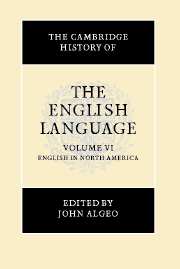Book contents
- Frontmatter
- 1 EXTERNAL HISTORY
- 2 BRITISH AND AMERICAN, CONTINUITY AND DIVERGENCE
- 3 BRITISH AND IRISH ANTECEDENTS
- 4 CONTACT WITH OTHER LANGUAGES
- 5 AMERICANISMS
- 6 SLANG
- 7 DIALECTS
- 8 AFRICAN-AMERICAN ENGLISH
- 9 GRAMMATICAL STRUCTURE
- 10 SPELLING
- 11 USAGE
- 12 CANADIAN ENGLISH
- 13 NEWFOUNDLAND ENGLISH
- 14 American English Abroad
- Glossary of Linguistic Terms
- Bibliography
- Index
- THE CAMBRIDGE HISTORY OF THE ENGLISH LANGUAGE
10 - SPELLING
Published online by Cambridge University Press: 28 March 2008
- Frontmatter
- 1 EXTERNAL HISTORY
- 2 BRITISH AND AMERICAN, CONTINUITY AND DIVERGENCE
- 3 BRITISH AND IRISH ANTECEDENTS
- 4 CONTACT WITH OTHER LANGUAGES
- 5 AMERICANISMS
- 6 SLANG
- 7 DIALECTS
- 8 AFRICAN-AMERICAN ENGLISH
- 9 GRAMMATICAL STRUCTURE
- 10 SPELLING
- 11 USAGE
- 12 CANADIAN ENGLISH
- 13 NEWFOUNDLAND ENGLISH
- 14 American English Abroad
- Glossary of Linguistic Terms
- Bibliography
- Index
- THE CAMBRIDGE HISTORY OF THE ENGLISH LANGUAGE
Summary
American English spelling began as a set of patterns, rules, and preferences that traveled across the Atlantic from England in the seventeenth century on the Mayflower, the Arbella, and dozens of other ships bringing people, books, and pamphlets from one continent to the other. From these beginnings the solidly British core was occasionally expanded and less frequently replaced to yield the orthography that prevails today in the American classroom, newspaper office, publishing house, and private home.
At the core of American orthography is a system that is derived from King Alfred and Abbot Æfric, Chaucer and the Chancery scribes, Shakespeare and Mulcaster, Johnson and Dryden, Murray and Hart and that is shared throughout the English-speaking and -writing world. But intermixed in that core are local preferences and innovations, including variations on specific spellings and spelling rules (for example, traveled, movable, jail), graphemic preferences (encyclopedia, esthetics), and nonstandard commercial uses of orthography (Exxon, Chik-n Flav-r). The origins and evolution of these variations are one concern of this chapter.
No comprehensive history of American English spelling has been written. Krapp (1925, vol. 1) deals almost exclusively with spelling reform and is dated, as is Mencken (1936), which is more comprehensive. Brander Matthews (1892), like Mencken (1936), attempts to contrast American and British spelling, but is no longer current.
Another interest is American orthographic invention that has not resulted in differences between English and American spelling but reflects American attitudes and interests in orthography. American spelling reform movements and attempts to install modified alphabets are one part of this interest.
- Type
- Chapter
- Information
- The Cambridge History of the English Language , pp. 340 - 357Publisher: Cambridge University PressPrint publication year: 2001
- 5
- Cited by

